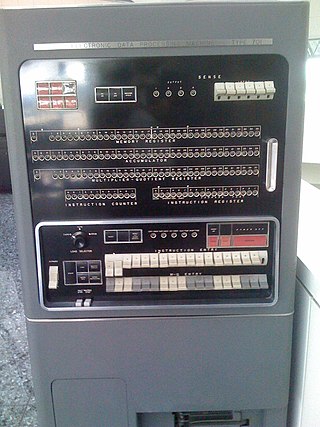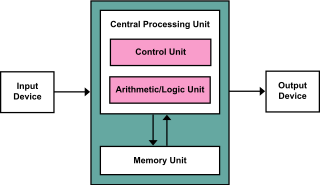Related Research Articles

A central processing unit (CPU), also called a central processor, main processor, or just processor, is the most important processor in a given computer. Its electronic circuitry executes instructions of a computer program, such as arithmetic, logic, controlling, and input/output (I/O) operations. This role contrasts with that of external components, such as main memory and I/O circuitry, and specialized coprocessors such as graphics processing units (GPUs).
In computer science, an instruction set architecture (ISA) is an abstract model that generally defines how software controls the CPU in a computer or a family of computers. A device or program that executes instructions described by that ISA, such as a central processing unit (CPU), is called an implementation of that ISA.

The Harvard architecture is a computer architecture with separate storage and signal pathways for instructions and data. It is often contrasted with the von Neumann architecture, where program instructions and data share the same memory and pathways. This architecture is often used in real-time processing or low-power applications.

The program counter (PC), commonly called the instruction pointer (IP) in Intel x86 and Itanium microprocessors, and sometimes called the instruction address register (IAR), the instruction counter, or just part of the instruction sequencer, is a processor register that indicates where a computer is in its program sequence.
A one-instruction set computer (OISC), sometimes referred to as an ultimate reduced instruction set computer (URISC), is an abstract machine that uses only one instruction – obviating the need for a machine language opcode. With a judicious choice for the single instruction and given arbitrarily many resources, an OISC is capable of being a universal computer in the same manner as traditional computers that have multiple instructions. OISCs have been recommended as aids in teaching computer architecture and have been used as computational models in structural computing research. The first carbon nanotube computer is a 1-bit one-instruction set computer.

Content-addressable memory (CAM) is a special type of computer memory used in certain very-high-speed searching applications. It is also known as associative memory or associative storage and compares input search data against a table of stored data, and returns the address of matching data.
In parallel computer architectures, a systolic array is a homogeneous network of tightly coupled data processing units (DPUs) called cells or nodes. Each node or DPU independently computes a partial result as a function of the data received from its upstream neighbours, stores the result within itself and passes it downstream. Systolic arrays were first used in Colossus, which was an early computer used to break German Lorenz ciphers during World War II. Due to the classified nature of Colossus, they were independently invented or rediscovered by H. T. Kung and Charles Leiserson who described arrays for many dense linear algebra computations for banded matrices. Early applications include computing greatest common divisors of integers and polynomials. They are sometimes classified as multiple-instruction single-data (MISD) architectures under Flynn's taxonomy, but this classification is questionable because a strong argument can be made to distinguish systolic arrays from any of Flynn's four categories: SISD, SIMD, MISD, MIMD, as discussed later in this article.
Plessey System 250, also known as PP250, was the first operational computer to implement capability-based addressing, to check and balance the computation as a pure Church–Turing machine. Plessey built the systems for a British Army message routing project.

The von Neumann architecture—also known as the von Neumann model or Princeton architecture—is a computer architecture based on a 1945 description by John von Neumann, and by others, in the First Draft of a Report on the EDVAC. The document describes a design architecture for an electronic digital computer with these components:
A processor register is a quickly accessible location available to a computer's processor. Registers usually consist of a small amount of fast storage, although some registers have specific hardware functions, and may be read-only or write-only. In computer architecture, registers are typically addressed by mechanisms other than main memory, but may in some cases be assigned a memory address e.g. DEC PDP-10, ICT 1900.
The First Draft of a Report on the EDVAC is an incomplete 101-page document written by John von Neumann and distributed on June 30, 1945 by Herman Goldstine, security officer on the classified ENIAC project. It contains the first published description of the logical design of a computer using the stored-program concept, which has come to be known as the von Neumann architecture; the name has become controversial due to von Neumann's failure to name other contributors.
A von Neumann language in computing is a programming language that is a high-level abstract isomorphic copy of a von Neumann architecture. As of 2009, most current programming languages fit into this description, likely as a consequence of the extensive domination of the von Neumann computer architecture during the past 50 years.

In computing, single instruction stream, single data stream (SISD) is a computer architecture in which a single uni-core processor executes a single instruction stream, to operate on data stored in a single memory. This corresponds to the von Neumann architecture.
Dataflow architecture is a dataflow-based computer architecture that directly contrasts the traditional von Neumann architecture or control flow architecture. Dataflow architectures have no program counter, in concept: the executability and execution of instructions is solely determined based on the availability of input arguments to the instructions, so that the order of instruction execution may be hard to predict.

Hardware acceleration is the use of computer hardware designed to perform specific functions more efficiently when compared to software running on a general-purpose central processing unit (CPU). Any transformation of data that can be calculated in software running on a generic CPU can also be calculated in custom-made hardware, or in some mix of both.

The history of computer science began long before the modern discipline of computer science, usually appearing in forms like mathematics or physics. Developments in previous centuries alluded to the discipline that we now know as computer science. This progression, from mechanical inventions and mathematical theories towards modern computer concepts and machines, led to the development of a major academic field, massive technological advancement across the Western world, and the basis of a massive worldwide trade and culture.
Capp or CAPP may refer to:

A computer is a machine that can be programmed to automatically carry out sequences of arithmetic or logical operations (computation). Modern digital electronic computers can perform generic sets of operations known as programs. These programs enable computers to perform a wide range of tasks. The term computer system may refer to a nominally complete computer that includes the hardware, operating system, software, and peripheral equipment needed and used for full operation; or to a group of computers that are linked and function together, such as a computer network or computer cluster.

The Little Man Computer (LMC) is an instructional model of a computer, created by Dr. Stuart Madnick in 1965. The LMC is generally used to teach students, because it models a simple von Neumann architecture computer—which has all of the basic features of a modern computer. It can be programmed in machine code or assembly code.
A modified Harvard architecture is a variation of the Harvard computer architecture that, unlike the pure Harvard architecture, allows memory that contains instructions to be accessed as data. Most modern computers that are documented as Harvard architecture are, in fact, modified Harvard architecture.
References
- Kent, Allen (1990), Encyclopedia of microcomputers: Volume 4 - Computer-Related Applications: Computational Linguistics to dBase, New York: Dekker, pp. 138–139, ISBN 0-8247-2703-7
- Foster, Caxton C (1976), Content Addressable Parallel Processors , Van Nostrand Reinhold, ISBN 0-442-22433-8
- ↑ "associative processor" . Retrieved 2021-03-14.